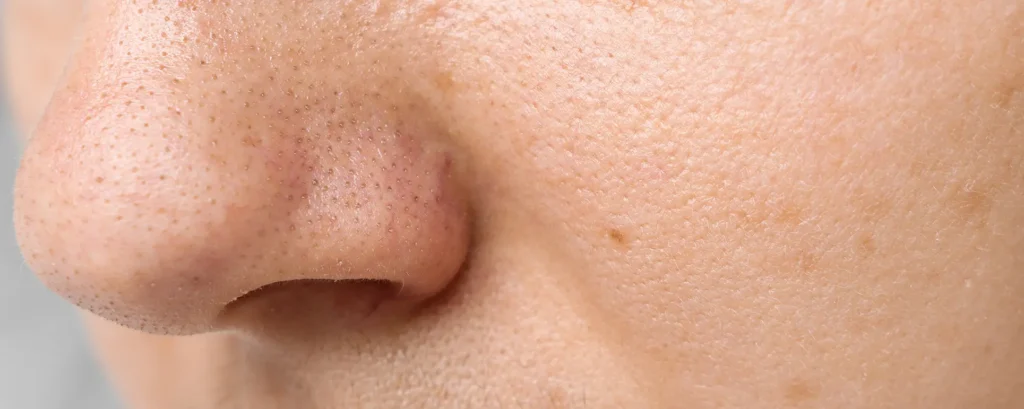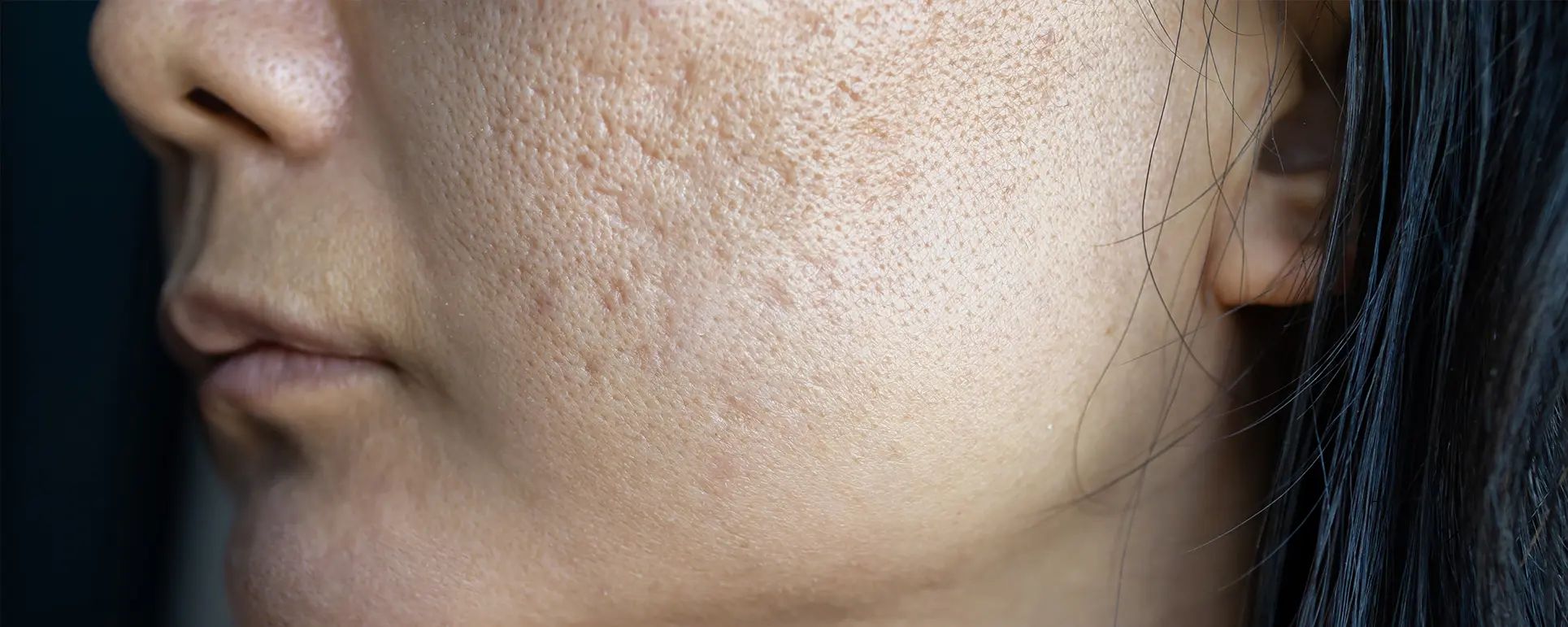Large pores are a very common cosmetic concern that affects countless individuals, regardless of age, skin tone, or gender. They often create a textured, uneven appearance on the skin’s surface and can make the complexion look oily or less refined. While pores are a natural and essential part of the skin allowing sweat and sebum to reach the surface and protect it they can sometimes become enlarged, making them more noticeable than desired. For some, this is only a minor visual concern, but for others, it can significantly affect self-confidence, especially in today’s world of high-resolution cameras and social media close-ups.
The size of your pores can be influenced by several factors, including genetics, excessive oil production, skin type, ageing, sun exposure, and even lifestyle habits. Over time, the skin’s natural elasticity decreases, and the supporting structures around pores can weaken, making them appear larger. Additionally, build-up of dead skin cells, dirt, or makeup can clog pores, stretching them further and contributing to breakouts and uneven texture. While many over-the-counter skincare products claim to reduce pore size, their effects are often temporary and subtle, especially if the root cause is not addressed.
This is where the expertise of a dermatologist can be invaluable. A skilled dermatologist in London can not only help identify the underlying reasons behind your enlarged pores but also design a customised treatment plan using advanced, evidence-based techniques. These may include medical-grade skincare, in-office procedures like chemical peels or laser treatments, and guidance on long-term maintenance to prevent pores from appearing larger again.
In this article, we’ll explore what causes enlarged pores, the role a dermatologist plays in improving their appearance, and the most effective treatments available today to help you achieve a smoother, more radiant complexion.
1. What Causes Large Pores?
Enlarged pores are one of the most common skin texture concerns and can affect people of all ages. While they are a completely normal part of our skin’s anatomy, their appearance can become more noticeable due to a combination of internal and external factors. Understanding these causes in detail is the first step toward finding the most effective solutions.
Excess Sebum Production
One of the primary reasons pores appear larger is overactive sebaceous glands, which produce sebum the skin’s natural oil. Sebum plays a vital role in keeping the skin hydrated and protected, but when produced in excess, it can accumulate inside pores. Over time, this excess oil stretches the pore walls, giving them a more dilated, visible appearance.
This is especially common in individuals with oily or combination skin types, and the effect is most pronounced in the T-zone (forehead, nose, and chin). Factors such as hormonal changes, diet, stress, and improper skincare can all trigger increased oil production, making pores more noticeable.
Ageing and Loss of Skin Elasticity
As we age, our skin naturally undergoes structural changes. Collagen and elastin two proteins responsible for skin firmness and resilience begin to break down, and the skin’s ability to regenerate slows. When the supportive framework of the skin weakens, the tissue surrounding the pores can sag slightly, making them look larger and less defined.
In addition, older skin tends to retain more dead skin cells on the surface because of slower cell turnover. This build-up can cling to the edges of pores, making them look more prominent. This is why enlarged pores are a concern not only for younger people with oily skin but also for those in their 40s, 50s, and beyond.
Genetics
Genetics play a significant role in determining your natural pore size. If one or both of your parents have visibly larger pores, there’s a strong chance you may inherit this trait. People with naturally oily skin or thicker skin textures often linked to ethnicity are more prone to enlarged pores from the start. While genetic factors can’t be changed, targeted skincare and professional treatments can still greatly improve how pores appear.
Sun Damage
Long-term exposure to the sun’s ultraviolet (UV) rays doesn’t just cause pigmentation or premature wrinkles it also damages the deeper layers of the skin. UV rays break down collagen and elastin, which are essential for keeping pores tight and skin firm. When these fibres weaken, the skin loses its elasticity, allowing pores to appear larger and less uniform in shape.
Sun exposure can also cause the outer layer of skin to thicken as a defense mechanism. While this thickening sounds protective, it actually makes pores more visible because the edges around them become more pronounced. This is why daily broad-spectrum sunscreen is essential not just for preventing sunburn but also for maintaining refined-looking skin.
Clogged Pores
When dirt, dead skin cells, excess sebum, and even makeup residue collect inside pores, they can become clogged. This blockage causes the pore to stretch out over time. If not addressed, clogged pores can lead to blackheads, whiteheads, and acne, all of which can further damage and enlarge the pore walls.
Clogged pores are particularly common in urban environments where pollution particles can settle on the skin. This makes proper cleansing, exfoliation, and avoiding pore-blocking products crucial in any skincare routine.
Lifestyle and Environmental Factors
Beyond the biological causes, certain lifestyle habits can also contribute to larger-looking pores. Smoking, for example, reduces collagen production and weakens the skin’s structure, while poor diet and dehydration can lead to a dull, uneven texture. Environmental pollutants, lack of proper skin cleansing, and sleeping with makeup on can all speed up pore enlargement.
In short: Pore size is influenced by a mix of factors some within your control, such as skincare and sun protection, and others, like genetics, that you cannot change. However, even if you can’t completely shrink your pores, you can take steps to make them appear smaller, cleaner, and less noticeable with the right approach.
2. How Can a Dermatologist Help?

While skincare products at home can help maintain skin health, the most significant improvements in pore size and skin texture often come from professional treatments. A qualified dermatologist in London can offer expert guidance, assess your skin’s unique needs, and recommend evidence-based treatments that go beyond what over-the-counter solutions can achieve. Their approach typically addresses two main goals:
- Preventing further pore enlargement by targeting the root causes, such as excess oil production, sun damage, or skin laxity.
- Improving the appearance of existing enlarged pores through treatments that refine skin texture, boost collagen, and clear blockages.
Professional Treatments May Include:
Chemical Peels
Dermatologists often recommend medical-grade chemical peels, which use exfoliating acids such as glycolic acid, salicylic acid, or trichloroacetic acid (TCA) to gently remove the top layer of dead skin cells. By clearing away debris and unclogging pores, peels help refine skin texture, improve light reflection on the skin, and make pores appear smaller. Regular sessions can also reduce oiliness and prevent future congestion.
Laser Treatments
Advanced laser technologies such as fractional CO₂ lasers, Nd:YAG lasers, or non-ablative fractional resurfacing work by stimulating collagen production deep within the skin. This increased collagen tightens the tissue surrounding the pores, making them look smaller over time. Laser treatments can also target pigmentation, acne scars, and uneven skin tone, providing a more uniform and youthful appearance overall. Many modern laser therapies are minimally invasive, with little to no downtime.
Microneedling
Also known as collagen induction therapy, microneedling involves using ultra-fine needles to create controlled micro-injuries in the skin. These tiny punctures trigger the body’s natural healing process, leading to increased collagen and elastin production. As the skin becomes firmer and more elastic, the surrounding pore walls tighten, reducing their visible size. Microneedling can also enhance the absorption of serums and active ingredients applied during treatment, maximising results.
Prescription Topicals
For long-term pore management, dermatologists may prescribe topical treatments containing retinoids (such as tretinoin or adapalene) to regulate sebum production and boost cell turnover. These medications can prevent pores from becoming clogged and gradually improve skin texture. In some cases, other medicated creams containing azelaic acid or niacinamide may be recommended to control inflammation and strengthen the skin barrier.
Extraction Procedures
Even with diligent home cleansing, pores can accumulate stubborn debris that is difficult to remove without professional help. In-office extraction procedures use sterile tools and techniques to safely remove blackheads, whiteheads, and hardened sebum plugs from the pores. This instantly improves smoothness and prevents further stretching of the pore walls.
A dermatologist’s strength lies in creating a customised treatment plan combining one or more of these procedures with a tailored home care routine to address both the cause and the appearance of enlarged pores. This professional guidance ensures that treatments are safe, effective, and suited to your specific skin type and lifestyle.
3. Daily Skincare Habits to Support Treatment

While professional treatments from a dermatologist can deliver impressive results, your day-to-day skincare routine plays a critical role in maintaining those improvements and preventing pores from becoming enlarged again. Consistent care at home not only supports the effectiveness of in-office procedures but also keeps your skin balanced, healthy, and refined over the long term.
Here are some dermatologist-recommended habits to incorporate into your routine:
Gentle Cleansing
Clean skin is the foundation of pore care. Use a mild, sulfate-free cleanser twice a day once in the morning and once before bed to remove excess oil, sweat, pollution particles, and impurities. This helps prevent blockages that can stretch the pores over time. Avoid harsh cleansers that strip away too much natural oil, as this can cause the skin to produce even more sebum to compensate. If you wear makeup or sunscreen, consider using the double cleansing method in the evening: start with an oil-based cleanser to dissolve makeup, followed by a gentle foaming or cream cleanser to remove any residue.
Exfoliation
Regular exfoliation is essential for keeping pores clear and skin smooth. By removing the layer of dead skin cells that can collect around pore openings, exfoliation helps prevent congestion and reduces the appearance of enlarged pores. Instead of abrasive scrubs that may cause micro-tears or irritation, opt for chemical exfoliants containing AHAs (alpha hydroxy acids like glycolic or lactic acid) or BHAs (beta hydroxy acids like salicylic acid). AHAs smooth the skin’s surface, while BHAs penetrate deeper into pores to clear oil and debris. For most skin types, 2–3 times per week is enough.
Sun Protection
Daily broad-spectrum SPF is one of the most important steps for keeping pores from becoming more visible. UV rays break down collagen and elastin in the skin, leading to sagging and a loss of firmness around the pores. Over time, this makes them appear larger. Apply sunscreen with at least SPF 30 every morning, even on cloudy days or when indoors near windows. Look for lightweight, non-comedogenic formulas that won’t clog pores, and reapply every two hours if you’re outside for extended periods.
Non-Comedogenic Products
The skincare and makeup products you use daily can either help or hinder your pore health. Choose non-comedogenic moisturisers, serums, foundations, and sunscreens these are specifically formulated not to block pores. Avoid heavy, greasy creams if you have oily or acne-prone skin, as they can contribute to congestion. Ingredients like niacinamide can be especially beneficial, as they help regulate oil production, strengthen the skin barrier, and improve texture over time.
Additional Tips for Healthy Pores
- Stay hydrated to keep skin plump and elastic.
- Remove makeup before bed to avoid overnight pore clogging.
- Maintain a balanced diet rich in antioxidants to support skin repair and collagen production.
- Avoid excessive touching of the face, as it can transfer dirt and bacteria to the skin.
By combining these daily habits with the treatments prescribed by your dermatologist, you can significantly improve and maintain the appearance of your pores. Consistency is key healthy pores are not the result of a single treatment or product, but of ongoing care and protection.
4. When to See a Dermatologist

While it’s normal for everyone to have visible pores, there are times when professional help becomes necessary. If you notice that your pores seem to be getting larger over time, your skin remains persistently oily despite using the right products, or your at-home treatments aren’t delivering the results you want, it may be time to seek expert advice from a qualified dermatologist in London.
Dermatologists can perform a thorough skin assessment to identify the exact causes behind your enlarged pores. Sometimes, what looks like large pores may actually be acne scars, skin texture irregularities, or early signs of sun damage all of which require different treatment approaches. By getting a professional diagnosis, you can avoid wasting time and money on products that may not be suitable for your skin type.
Signs You Should Book an Appointment Include:
- Persistently large or worsening pores that do not improve with consistent skincare.
- Oily skin that remains greasy throughout the day, even after cleansing.
- Frequent breakouts, blackheads, or whiteheads that contribute to pore blockage.
- Skin texture changes such as roughness, sagging, or uneven tone.
- Post-acne marks or scars that make pores look more noticeable.
- Excessive sun exposure history leading to visible skin damage.
Why Professional Help Makes a Difference
A dermatologist can offer access to advanced treatments such as fractional lasers, prescription-strength retinoids, and microneedling with radiofrequency that are far more effective than over-the-counter products. They can also guide you on a long-term maintenanceplan to prevent pores from enlarging again, which might include lifestyle advice, customised skincare, and periodic in-office procedures.
Additionally, working with a dermatologist minimises the risk of side effects or skin irritation, as they can adjust treatments based on your skin’s response and medical history. This ensures that you achieve the best possible results safely and efficiently.
In short: If your pores are affecting your confidence or resisting your usual skincare efforts, don’t wait for the problem to worsen. A consultation with a dermatologist can set you on the path to smoother, healthier, and more refined-looking skin.
Final Thought: Your Journey to Refined, Healthy-Looking Skin
Large pores are a common concern, but they can be managed effectively with the right combination of professional treatments and at-home care. From chemical peels to laser therapies, dermatologists have the expertise to reduce pore size and improve skin texture. For those looking for a personalised plan, you can get in touch with a dermatologist in London to discuss treatments that will help your skin look smoother and healthier.
References:
- Parvar, S.Y., Amani, M., Shafiei, M., Rastaghi, F., Hosseini, S.A. & Ahramiyanpour, N., 2023. The efficacy and adverse effects of treatment options for facial pores: A review article. Journal of Cosmetic Dermatology, 22(3), pp.763–775. https://pubmed.ncbi.nlm.nih.gov/36440737/
- Lee, S.J., Seok, J., Jeong, S.Y., Park, K.Y., Li, K. & Seo, S.J., 2016. Facial pores: Definition, causes, and treatment options. Dermatologic Surgery, 42(3), pp.277–285.
https://pubmed.ncbi.nlm.nih.gov/26918966/ - Dong, J., Lanoue, J. & Goldenberg, G., 2016. Enlarged facial pores: An update on treatments. Cutis, 98(1), pp.33–36. https://cdn.mdedge.com/files/s3fs-public/issues/articles/CT098007033.PDF
- Roh, M., Han, M., Kim, D. & Chung, K., 2006. Sebum output as a factor contributing to the size of facial pores. British Journal of Dermatology, 155(5), pp.890–894.
https://academic.oup.com/bjd/article-abstract/155/5/890/6637358
Vachiramon, V., Chirasuthat, S., Boonpethkaew, S., Sakpuwadol, N., Yongpisarn, T. & Jurairattanaporn, N., 2025. A Study of Combined Onabotulinumtoxin A and Hyaluronic Acid Filler for the Treatment of Enlarged Facial Pores. https://www.mdpi.com/2072-6651/17/1/38
